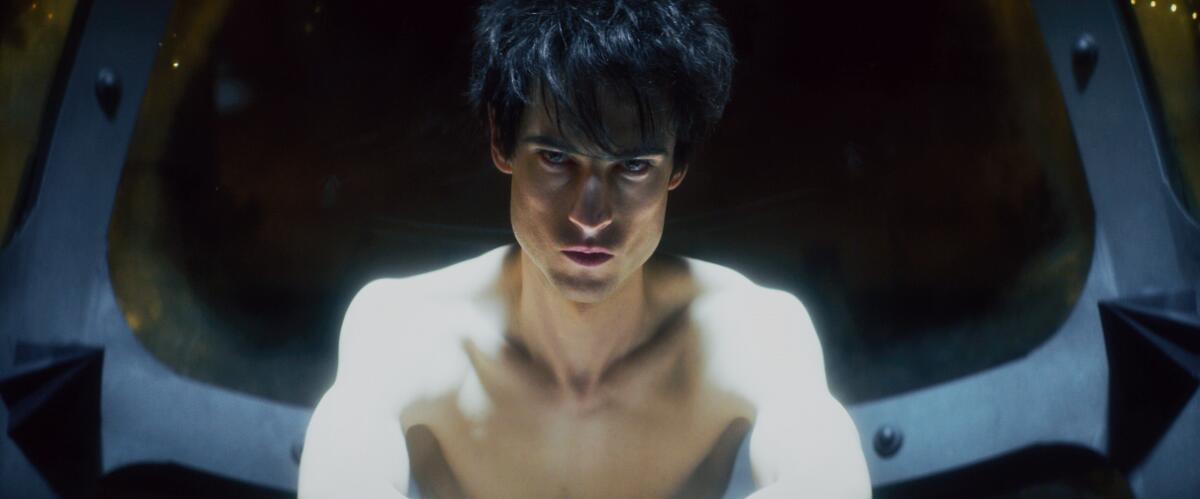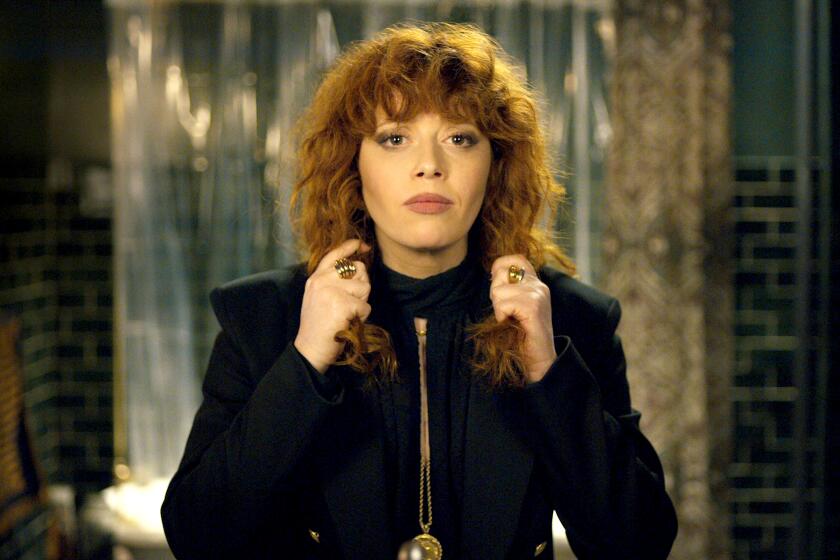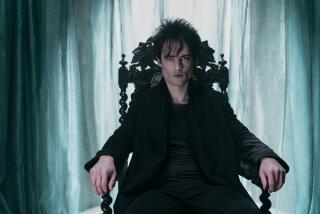Netflix’s lively, unusual adaptation makes the most of Neil Gaiman’s ‘The Sandman’

- Share via
After a failed attempt at a film adaptation, writer Neil Gaiman has shepherded his comic book epic “The Sandman,” a stew pot of invented and borrowed mythological characters, into a highly satisfying 10-episode Netflix series. “The great stories will always return to their original forms,” Gaiman’s eponymous hero will say, and fans of the book should rest assured that the television show — developed by Gaiman with David S. Goyer (the “Blade” trilogy, the “Dark Knight” trilogy) and Allan Heinberg (“Wonder Woman”) — will not significantly depart from what Gaiman (and artists Sam Kieth and Mike Dringenberg, always credited as co-creators) put on the page.
At the center of the story is Dream (Tom Sturridge), a.k.a. Morpheus, a.k.a. the Sandman, who rules the world of sleep and what goes on there from his CGI kingdom called the Dreaming; he’s one of a pack of magical siblings called the Endless whose names all begin with D (Desire, Despair, Destruction, and so on), who in some vague way rule human affairs, even though, like the Greek gods, they seem to spend much of their time not taking care of business or hatching plots against one another.
There are a lot of rules to how this world works, produced by Gaiman as necessary to serve his narrative, but it’s better to regard these figures as walking metaphors — “anthropomorphic personifications” in the series’ own words — and their antics and universe as a kind of poetry rather than fret over the cosmological mechanics. It’s not hard to go with the flow of the story, whether or not you know the original, or its antecedents, or any comics at all, or have ever seen a movie based on one. It’s a standalone world.
With his sticky-outy black hair, pale skin and dark attire, Dream cuts a goth (not a Gothic) figure, like a tall skinny version of the Cure’s Robert Smith; there are times early on when he seems to have the expressive blankness of a digitally created video game character, but this dissipates with time. Speaking softly as if not to wake anyone, he can be a bit stiff and mopey and formal, and unlike his life-affirming older sister Death (a glorious Kirby Howell-Baptiste), the only member of the family with whom he gets along, he’s not much of a people person. But ultimately he’s on the side of humanity and the waking world, and much of the action involves his trying to keep the two interconnected worlds — ours and his — whole, hale and extant.
We surveyed The Times TV team to come up with a list of the 75 best TV shows you can watch on Netflix. As in, tonight.
The series begins in 1916. Sir Roderick Burgess (Charles Dance), “a rival of Aleister Crowley” who has been trying to capture Death in order to resurrect his son, accidentally captures Dream instead, stealing his “tools” (a helm, a ruby and a pouch of sand) and keeping him prisoner while he tries to extract some gift of power. With the younger son taking over as jailer, this goes on for a century, until Dream contrives to escape. He finds his once-pretty CGI kingdom in ruins and in order to rebuild it needs to get his stuff back, setting off on a quest that will take him to contemporary London, the United States and Hell. Meanwhile, some of his creations — personified dreams and nightmares — have fled to the waking world, notably the Corinthian (Boyd Holbrook), the season’s main antagonist, a nightmare who has been running amok there as a serial killer.
There is some switching of genders from the books: Lucifer (Gwendoline Christie) is now female, Dream’s librarian and right hand Lucienne (Vivienne Acheampong) used to be Lucien, and demon-hunting John Constantine has been folded into Johanna Constantine (Jenna Coleman), originally a separate character. So too of race. Certain fans of the comic will cavil, as certain fans always do, but as someone coming at the TV show and the books in reverse order, it all looks to me like an improvement — interesting at worst.
We’re decades on from the series’ publication, and Gaiman (and his collaborators) may have had some better ideas. The rethinking makes the show more vibrant and balanced and contemporary, and no reasonable viewer could fault the performances of the actors who don’t resemble their graphic originals; each is splendidly who they need to be. Change is an explicit theme of “The Sandman,” and if an immortal can learn to loosen up a little, so can we. Beyond that, the history of comics generally, and of the Sandman character in particular — which Gaiman plucked from the DC archives and built a new world around — is one of constant remodeling.
And inevitably, as soon as you put human actors in the skin of pen and ink characters, you are bound to get something new and different, something with fresh shades of meaning, something whose constant, often subtle modulations of voice and expression and intention comics can only suggest; the quiet brilliance of David Thewlis as sad quasi-villain John Dee is a case in point. That isn’t a dig against comics, which are their own medium, but beyond the mere exploitation of IP, the only reason to make these adaptations is to Bring Them to Life. And “The Sandman” is very lively indeed.
Neil Gaiman, creator of the revered comic ‘The Sandman,’ is the worst nightmare of fans who object to how Netflix has cast its series adaptation.
Based as it is on the first 16 issues of the 75-issue series, collected as the graphic novels “Preludes and Nocturnes” and “The Doll’s House,” “The Sandman” is built from longer and shorter arcs, some lasting the season, others a few episodes or even just part of an episode. Some are extremely dark, others are relatively lighthearted, and even the digressions add something to the greater, interconnected mythology or work upon Dream’s understanding of himself. Some characters leave early, some arrive late. The pacing feels unusual at first — well, it is unusual — but it works and has the advantage of spending the right amount of time on any storyline; the series feels neither hurried nor bloated.
Dream’s seriousness, his feudal formality and his inability to make or even get a joke, practically demand that the story be leavened with humor. So it’s good to find comedian Patton Oswalt as the voice of Dream’s raven, Matthew; Stephen Fry as Gilbert, a chivalrous Edwardian sort of gentleman who comes to the aid of human “dream vortex” Rose Walker (Kyo Ra); and a cute baby gargoyle named Goldie, the pet of a Tweedledee-Tweedledum version of Cain (Sanjeev Bhaskar) and Abel (Asim Chaudhry).
While it’s not quite right to say that the series is at its best when at its funniest — it handles horror … horrifyingly — it is certainly when it’s most companionable. (“Who do I invoice for this, Church of England or Buckingham Palace?” Johanna Constantine asks, having performed an exorcism involving a royal.) Some of Dream’s creations (including janitor Mervyn Pumpkinhead — his name describes him — voiced in a guttural New York accent by Mark Hamill), talk about him behind his back, a happy counterweight to the “my lord” deference they are constrained to pay him to his face.
Indeed, Dream’s learning to live a little, to understand his own humanity, as it were, is the emotional spine of the story, and Sturridge gets a lot of expressive mileage out of cracking the slimmest of smiles. Immortals who need people are the luckiest immortals in the world.
More to Read
The complete guide to home viewing
Get Screen Gab for everything about the TV shows and streaming movies everyone’s talking about.
You may occasionally receive promotional content from the Los Angeles Times.









